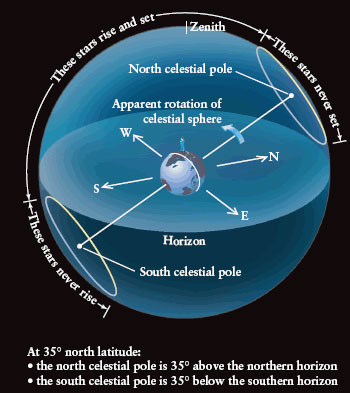
Chapter 2. Motions of Stars
2.1 Introduction

Author: Scott Miller, Pennsylvania State University
Editor: Grace L. Deming, University Of Maryland
Media: JustAsk!

The goals of this module: At the end, you should be able to:
- Explain why stars appear to rise and set.
- Determine the path of a star depending on where it rises.
- Determine the path of a star depending on where you are located on Earth.
In this module you will explore:
- The rise and set positions of stars as observed from mid-northern latitudes
- The path a star will follow as it rises in the east and sets in the west
- How the path of a star changes with the latitude of the observer
Why you are doing it: Since ancient times, people have noticed that the positions of stars move across the sky. By completing this activity, you will not only understand why the stars appear to move over time, but in what manner they appear to move, and how that motion varies for observers at different latitudes.
2.2 Background

While today we know that stars lie at various distances from Earth, this was not always common knowledge. Ancient astronomers believed that all stars were fixed on a sphere surrounding Earth, called the celestial sphere. While this is not true, astronomers find this model of a celestial sphere helpful in visualizing the positions and motions of celestial objects.
For a person standing on Earth, he can view the half of the celestial sphere above his horizon. The horizon is defined as the boundary where the ground meets the sky. An observer can see everything above his horizon, but the ground blocks his view of everything below it.
Look at the figure to the right. In it you can see a person standing on Earth at a latitude of 35°N. His horizon is indicated as a plane, which bisects the celestial sphere. The person can see everything on the top half of the celestial sphere, but nothing on the bottom half. To indicate directions on Earth, we have created a system of coordinates based on a person's position on Earth. When facing the North Pole, a person is facing north, while south is in the opposite direction. In this orientation, east is to the right, while west is to the left. Keep in mind that these labels pertain to directions on Earth only! They do not pertain to directions in space.
As you watch the animation below, you will notice that the observer's view of the sky changes; what he can see at one point in time changes as the celestial sphere rotates. Remember, it is really the rotating Earth that produces this motion. You can try deselecting "fix earth" to see earth rotating.
Question 1.
In which direction would you look to see the stars rising above the horizon?
| A. |
| B. |
| C. |
| D. |
2.3 Rising of the stars
Let's change our point of view from space to the observer on Earth. In the animation set the direction to 180° - pointing east. Then select "view from earth". Directly in front of us represents the direction we are facing (in this case, east). The left corner represents the horizon on our left (in this case north). The right corner represents the horizon on our right (in this case south). Here we see what the observer will see as he watches the stars rise above the horizon. You can also change the "look up" angle to 90° to view the zenith (the point directly overhead).
Question Sequence
Question 2.
Do all stars rise exactly due east?
| A. |
| B. |
Question 3.
For a star which does rise exactly due east, in which direction would you look to observe it when it is highest in the sky? (Hint: Use the default latitude of 35 North.)
| A. |
| B. |
| C. |
2.4 Paths Of The Stars
Due to the rotation of Earth and the observer's latitude, all stars will trace out paths parallel to each other. In the animation below check "Leave trails" to see the trails of 3 stars.
Question Sequence
Question 4.
For an observer positioned at latitude 35°N where would a star which does pass overhead rise?
| A. |
| B. |
| C. |
Question 5.
For an observer positioned at latitude 35°N where would a star which does pass overhead set?
| A. |
| B. |
| C. |
Summary
How would you describe the path of a star which rises due east and sets due west for a person living in the northern hemisphere?
In which direction would it move as it rises above the horizon and in which direction you would have to face when viewing it highest in the sky?
Based on what we've discovered above, stars which rise due east will move southward as they get higher in the sky, such that when they reach their highest point you would need to face due south to see them. They would then move back northward as they appear to descend, until they set due west.
2.5 Other Points Of View
Everything we've done so far has been for a person who lives at mid-northern latitudes (specifically, around 35° N latitude.) Let's see how stars appear to move across the sky at other latitudes.
Click on the up and down latitude arrows to change the latitude and you will see how the celestial sphere is oriented and how the stars appear.
Make sure you check out these specific locations:
90° N latitude (the North Pole)
35° N latitude
0° Latitude (the Equator)
35° S latitude
90° S latitude (the South Pole)
Question 6.
Is there any location on Earth where a star which rises exactly due east does pass directly overhead?
| A. |
| B. |
| C. |
| D. |
Summary
If an observer on the equator observes stars rising straight up over the eastern horizon and setting straight down towards the western horizon, what would an observer at the North Pole see?
She would see the stars moving in horizontal circles parallel to the horizon; never rising nor setting.
What about observers in the southern hemisphere?
They would see exactly the same thing, but reversed. At mid-southern latitudes, stars which rise due east would move high through the northern sky before setting due west, and a star which passes directly overhead would have risen south of east before passing overhead and setting south of west.
2.6 Quick Check Quiz
Indepth Activity: Motions of Stars
Answer the following questions. You may use the animation as a reference.
Question 7.
No matter where you are located, a star that rises due east will pass overhead before setting due west.
| A. |
| B. |
Question 8.
Stars at the North Pole will appear to revolve counter-clockwise around the sky while stars at the South Pole will appear to revolve clockwise around the sky.
| A. |
| B. |
Question 9.
For an observer at a mid-northern latitude, a star rises north of due east and passes directly overhead. Where will it set?
| A. |
| B. |
| C. |
| D. |
Question 10.
In the northern hemisphere, for a star which rises due east, who will observe it higher in the sky when it reaches its highest point?
| A. |
| B. |
| C. |
| D. |
Question 11.
An observer at 35° N latitude observes a star rise due east, while an observer at 35° S latitude also observes a star rise due east at the same time. Which of the following is false?
| A. |
| B. |
| C. |
| D. |
Activity results are being submitted...